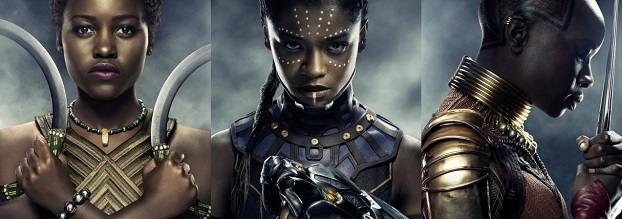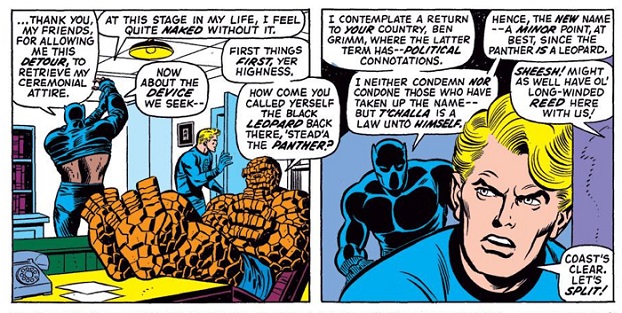
Saw Black Panther, crushed intensely on Lupita Nyong’o and Danai Gurira, generally lusted after the jewelry worn by various characters, and had some thoughts. There may be spoilers below so read at your own peril.
· Not to take credit away from Black Panther for raking in the millions, but it’s just weird how there’s so much gasping about a film with a black hero doing well at the box office. It’s as though everyone’s forgotten the likes of Eddie Murphy and Will Smith have been there and done that.
· For me, what was path breaking was to see a film with three strong female leads who don’t succumb to stereotype and who are, let’s face it, way cooler than the hero they champion. The women in Black Panther are among the best written roles we’ve seen in the Marvel universe and somewhere out there, Black Widow is weeping at what a raw writing deal she got.
“The women in Black Panther are among the best written roles we’ve seen in the Marvel universe.”
Nakia the spy (Nyong’o), Okoye the warrior (Gurira) and Shuri the inventor (Letitia Wright) are magnificent. They’re independent, feisty and indomitable. Technically, they’re all Black Panther’s sidekicks, but they hold their own. Even when Nakia and Okoye just walking in with T’Challa, there’s so much character and charisma emanating from Nyong’o and Gurira that you’d never make the mistake of thinking they’re just eye candy.
I love that they’re also physically different from one another, which is emphasized by Rachel Morrison’s wonderful cinematography. Her camera is alert to the stunning beauty of muscles rippling when Nakia lashes out at a bad guy, of the fighter’s grace in Okoye’s body.
· A black hero is a big deal for Marvel, sure. The comic book Black Panther was created a little before the Black Panther Party and Marvel has done its damnedest to distance the two. At one point T’Challa was renamed “Black Leopard,” which is better than “Coal Tiger” (Stan Lee’s original name for the character) but it didn’t stick with readers. So he became just “The Panther” when he appeared in one of the Fantastic Four’s adventures:

· With that history in mind, it’s particularly interesting that in Black Panther, director Ryan Coogler goes back to Oakland where the Black Panther Party was formed. We meet T’Challa’s uncle, N’Jobu, who wants to arm the black resistance with the miracle-metal vibranium. This is strictly against Wakanda’s policy of maintaining a cover of secrecy so that no outsiders find out about them. No one says Black Panther Party, but N’Jobu is obviously looking to arm them.
Killmonger is N’Jobu’s son and could have been one of the most dynamic and interesting villains in the Marvel universe because what he’s saying makes sense. It isn’t evil to say black people need to stand shoulder to shoulder. When Killmonger tells Wakanda to wake up and see what’s happening outside its borders, you can’t help but agree with him. Killmonger has grown up in America, dreaming of Wakanda, power and vibranium. From Oakland to CIA, his violence has been nurtured and honed so that he becomes a killing machine. He’s irreverent and committed to violence, perhaps because it’s been the only way he could command respect.
“When Killmonger tells Wakanda to wake up and see what’s happening outside its borders, you can’t help but agree with him.”
Just in case Killmonger seems a little too charismatic (Michael B. Jordan saying “Hi auntie” = gold) next to the blandly well-behaved and cocooned-in-privilege T’Challa, the focus shifts to him claiming the Wakandan throne. Instead of exploring how Killmonger wants to demolish racism with vibranium, all we get of him is bloodlust. He’s the outsider, the one with bad blood, the American who has come to destroy the African Eden of Wakanda. It’s worth noting that ultimately, T’Challa doesn’t ever end up debating with Killmonger. They only have physical fights and arguably, Killmonger gets the winning line when he tells T’Challa, “Bury me in the ocean with my ancestors who jumped from ships, because they knew death was better than bondage.”
Watching Eric Killmonger, I found it crazy that in a time when there are petitions to declare Black Lives Matter a terrorist group and FBI considers “black identity extremists” a threat, Black Panther‘s villain is an American who wants to arm the black resistance. The good American is apparently the white guy who just happens to also be in the CIA, Agent Ross. And the black hero? He’s inherently unreal, hailing as he does from an imaginary nation and with the nectar of a fantastical flower filling his body with superhuman strength.
Christopher Lebron unpacks the problems of how Killmonger is written in the movie and makes a superb comparison of Loki and Killmonger.
Been to #Wakanda once? Going back a second time? My review of #BlackPanther for @BostonReviewhttps://t.co/VJrBsNMNzT
— Chris Lebron (@lebron_chris) February 23, 2018
· This is me being a little pedantic I know, but can someone please explain what is going on with this vibranium? Ok, so it’s indestructible, great, but it seems to be doing an awful lot, like powering trains and just generally making Wakanda fabulous. What are its actual characteristics? No one tells us. We are just to bathe in its blue light and feel blissed out.
· There’s a scene in which we’re shown all the tribes of Wakanda. They’re dressed in their regalia, some are dancing, some are singing. It’s all very joyous, colorful and beautiful. To truly appreciate how much thought has gone into the costumes of Black Panther, see this Twitter thread. Ruth Carter is a goddess and all should bow before her for the incredible work she’s done in Black Panther. It’s just that watching the scene in which all the tribes gather to witness T’Challa defend his claim to the throne, all I could think of was that finally, in 2018, Africa is a country and its name is Wakanda. This would sit more comfortably with me if Wakanda didn’t feel a bit like a collection of tropes plucked out of many Nat Geo documentaries. We’re shown very little of Wakanda beyond swooping panoramas that show either stunning natural beauty or a glittering city. We don’t go into homes, we only hang around royals and the elite…it just all feels a little two-dimensional.
· We’re told Wakanda managed to avoid colonization and the horrors of slave trade, and yet Wakandans seem to be equally fluent in their mother tongue (which is actually Xhosa) and English. To acquire a language without its history or bloodstains — now that’s a fantasy if there ever was one.
“To acquire a language without its history or bloodstains — now that’s a fantasy…”
· As writers, Coogler and Joe Robert Cole had the freedom to make Wakanda anything they wanted it to be. Here’s what they conjured: a monarchy (all this vibranium-powered progress and no one wants voting rights?) in which citizens are all marked with a barcode (and you thought Aadhar’s surveillance potential was scary) so that only those with the right lineage get to breathe in a little bit of vibranium. Aspirants stake their claim to the throne through ritual combat (so much for an advanced, scientific society).
It’s also a strict patriarchy, which must be particularly frustrating since Wakanda is home to some amazing women. A woman becomes a queen by marriage and then stands around looking gorgeous and doing nothing (no wonder Nakia isn’t bouncing with excitement at the thought of being one). Even though his mother is alive and well, T’Challa must get his father’s blessings. A hallucination of a male patriarch is more valuable than a living, breathing queen in Wakanda. When T’Challa’s out of action, no one suggests Shuri take on the mantle of Black Panther even though it’s her tech that’s powering the Black Panther.
· Speaking of Shuri, what the hell kind of lab is part weapons design and part hospital? Totally love Wright though and she has some of the sassiest moments in Black Panther. Like, “When you said you would take me to California for the first time, I thought you meant Coachella.” And “Don’t scare me like that, colonizer!”
· If you watched Black Panther in India, then you missed a few details. One of them was this reference to Hanuman. Honestly, at this rate, I’m just going to have to stop watching movies in theaters.
So, the muting of the word 'Hanuman' in Black Panther on Indian screens is an act somewhere on the evil/stupidity spectrum.
1. The Hanuman being referred to here is Marvel's Wakandan gorilla god Hanuman, who is a Marvel character. Like Marvel's Thor.— Samit Basu (@samitbasu) February 21, 2018
Bottom line: Black Panther isn’t radical by a long shot, but it’s good fun and there need to be so many more films in which people of color dominate both visually and thematically. It’s just sad that even in the 21st century, a mainstream movie with a black cast and strong women characters is still considered left-field.
* * *
This post originally appeared on the blog of author, journalist and blogger Deepanjana Lal. Visit her website for more on her articles, books and photos.












